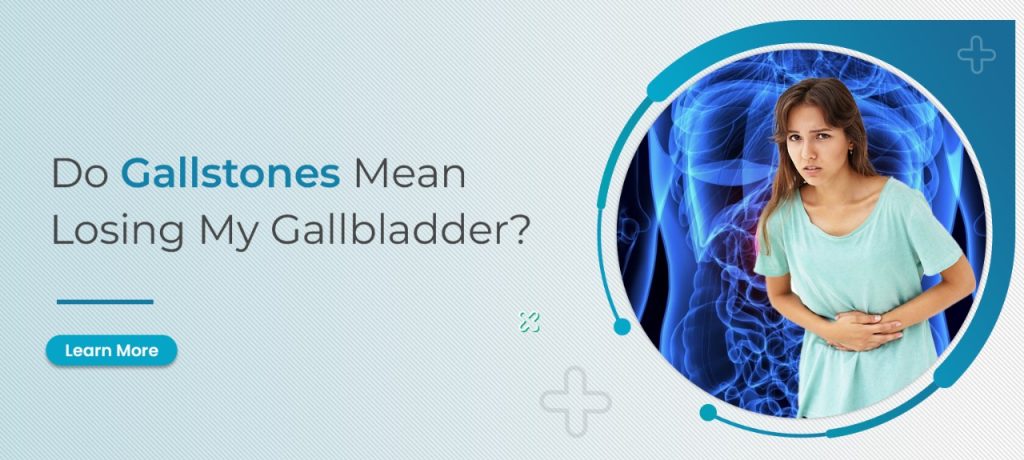The gallbladder is a very small pouch-sized body part that sits just under the liver. It’s a pear-shaped organ—the gallbladder stores bile inside it, produced by the liver. After having food, the gallbladder is flat and empty, like a deflated balloon. And before a meal, the gallbladder is full of bile and about the size of a small pear.
The gallbladder takes stored bile into the small intestine via a series of ducts. Bile helps digest fats, but the gallbladder itself is not an essential part of our body. Removing the gallbladder in an otherwise healthy individual generally causes no observable problems with health or digestion, yet there may be a small risk of diarrhea and fat malabsorption.
Stones in the gallbladder are called – “Gallstones.” Gallstones are solid deposits of digestive fluid from our food that can form in your gallbladder. Gallstones (stones of the gallbladder) can be of any size, from grain to golf ball. Some people develop just one stone in the gallbladder, while others may develop many gallstones; it depends on people. People who experience symptoms from their gallstones generally require gallbladder removal surgery. Gallstones that don’t cause any signs or symptoms typically don’t need treatment.
Types of gallstones
Types of gallstones are as follows:
- Cholesterol gallstones are the most common kind of gallstone, which often appears yellow.
- Pigment gallstones. These are dark brown or black-colored stones when your bile contains too much bilirubin.
Causes of Gallstones
Its exact reason is unpredictable, but doctors think gallstones may result when:
- Your bile contains too much cholesterol
- Your bile contains too much bilirubin.
- Your gallbladder doesn’t empty correctly.
Symptoms of Gallstones
Gallstones may cause no signs or symptoms. If a gallstone stays in a duct and causes a blockage, some signs and symptoms arise. A few of them are as follows:
- Sudden and rapidly pain in the upper right portion of your abdomen
- Nausea or vomiting
- Back pain between your shoulder blades
- Pain in your right shoulder
Gallstone pain can be either of few minutes or a few hours. Most gallbladder stones are not dangerous, but gallstones can become dangerous. Gallstones can pose a danger if they block the gallbladder and bile flow via it. Then you can get an infection within the gallbladder.
When Treatment Required
You should contact your dr if you develop signs and symptoms from the followings:
- Abdominal pain so intense that you can’t sit still or find a comfortable position
- Yellowness in your skin and the whites of your eyes (jaundice)
- High fever with chills
Gallstone Diagnosis
Your doctor will do a physical exam for this, and he might order tests including:
Blood tests.
- Ultrasound.
- CT scan
- Magnetic resonance cholangiopancreatography(MRCP).
- Cholescintigraphy (HIDA scan).
- Endoscopic retrograde cholangiopancreatography (ERCP).
- Endoscopic ultrasound
Gallstone Treatment
You don’t require treatment if you don’t have any symptoms. Some small gallstones can pass through your body on their own via urination. Most people with gallstones have their gallbladders taken out but on dr suggestion. You can still digest food without it. Your doctor can use any one out of two procedures.
- Laparoscopic cholecystectomy: This is a very common surgery for these gallstones. Your doctor passes a very narrow tube called a “laparoscope” into your belly through a very small cut. It holds instruments, like-a light, and a camera. They then take out your gallbladder through another small cut. You’ll usually go home on the same day.
- Open cholecystectomy –In this procedure, your doctor makes bigger cuts in your belly to remove your gallbladder. You’ll stay in the hospital for a few days after this surgery.
If gallstones are in your bile ducts, your doctor may use ERCP to find them and remove them before or during surgery. And if you have another medical condition and your doctor thinks you don’t need any surgery, they might give you medicines instead. They can cause mild diarrhea.
It is possible you may have to take medicine for many years to dissolve the stones, but they may come back after you stop taking them.






